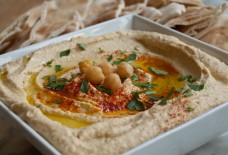Mediterranean Cooking from the Garden with Linda Dalal Sawaya: Sour grapes—making assir husroum and verjus
grapes in my backyard karam © linda dalal sawaya 2015
One of my favorite of many unforgettable meals while visiting my parents’ village of Douma, Lebanon last fall was dinner with my fabulous cousin, Elie, and his sweet and talented wife, Nabiha. We feasted on tomatoes and cucumbers from their garden in a salad dressed with home made “vinegar” that Nabiha had made in the summer with unripened grapes called assir husroum. It was light and delicious giving the salad a zing without much acidity.
Sitt Nabiha’s husroum © linda dalal sawaya 2015
Naturally, as it was my first taste of this, I asked Nabiha how she made it, and she kindly shared her process with me. Months later, her daughter helped me clarify the instructions via the internet. And finally now back in my garden, in mid-summer, I thinned my very dense Concord grapes for my first attempt at making assir husroum.
washing sour grapes © linda dalal sawaya 2015
The washed grapes need to have their stems removed, and are juiced in either a blender or a juicer; so I tried both methods. Grapes blended in the blender were then put through my Foley food mill to remove the skins and seeds. Food mills are called passatutto (Italian) or moulinette (French), and do the difficult job of puréeing foods with seeds or skins.
sour grapes ready to blend © linda dalal sawaya 2015
puréed grapes in the foley food mill © linda dalal sawaya 2015
In researching how to make assir husroum from grapes, I found a recipe for making verjus, a French word meaning green juice, also from sour, unripe green grapes. Since I love to experiment and I had picked so many grapes, I decided to make both to see how they compared. I learned that these ancient grape concoctions have been used over centuries for sauces, salads, marinades, and desserts. It is with delight that I begin this exploration! One recipe I found uses it as a dessert with poached pears. I can’t wait to try this with pears from my pear tree, from which the Bartletts are now ready to use.
strained grape juice © linda dalal sawaya 2015
The recipe for assir husroum that I wrote down as Nabiha gave it to me in Arabic was for every two liters of grape juice, to add ¼ cup of coarse sea salt, and to boil the mixture down to one half it’s original quantity. After putting the grapes through the food mill, I strained them through a fine mesh strainer, transferred the two liters of juice to an enamel pot, stirred in the salt, and brought the mixture to a boil. Then I turned the heat down and let it simmer for a couple of hours, resulting in 4 ¼ cups of delicious assir husroum that had been cooled and strained. It was ready to use!
salata dressed with olive oil and husroum © linda dalal sawaya 2015
Today, my friend Rima came over for lunch, and we shared a fresh garden salad dressed with yesterday’s home made husroum. It was just as I remember Sitt Nabiha’s! The flavor of the grapes comes through with a slight saltiness allowing all of the vegetables in the salad to come forth in a bright and refreshing way. Shukran, ya Nabiha ou sallem diyetic!
sour grapes with sea salt cooking © linda dalal sawaya 2015
residue from grape juice before decanting © linda dalal sawaya 2015
In Persian, husroum is called ab-ghooreh, and an Italian version of this is called acresta. Mediterranean grape growing cultures have used this preserved liquid in many ways over hundreds of years. It is a form of mounieh, preserving food for wintertime use, among other foods such as cheese from milk, olives and olive oil, raisins, grape leaves, kishk, arak, and so on.
verjus (left bottle) with husroum © linda dalal sawaya 2015
To make the verjus, the recipe I found used citric acid rather than salt, to preserve the color, preventing oxidation of the grapes. No cooking was involved, just juicing, straining, and mixing in the citric acid. The verjus has a lemony accent, and must be refrigerated and used within three months. The recipe called for ½ teaspoon of citric acid for three pounds of grapes.
Following this recipe produced 3 cups of verjus that did not stay bright green, and likely needs to be further strained once the particles have settled; the clear liquid at the top can be poured off and decanted; as you can see in the photo above, the particles are settling, and the liquid and the top is becoming clearer. The verjus has more taste of raw grapes since it is uncooked, and is lemony rather than salty. Both Rima and I preferred the assir husroum to the verjus, but we are Lebanese!
verjus and assir husroum © linda dalal sawaya 2015
In both, the resulting culinary sour juice is one I look forward to using in more summer salads, and in experimenting with as a marinade, in sauces, and even possibly in desserts. If you or your friends do not have a vineyard from which to harvest green grapes, you can purchase verjus and possibly husroum in specialty groceries or online. Sahtein and happy cooking!
story and all photos © linda dalal sawaya 2015



